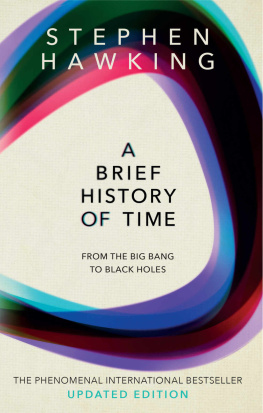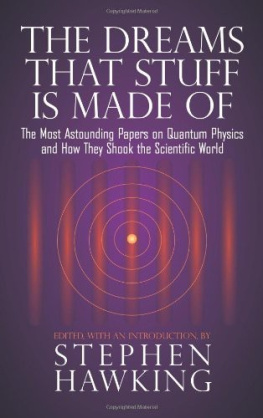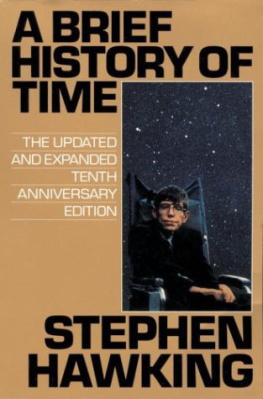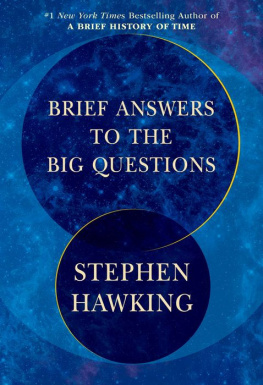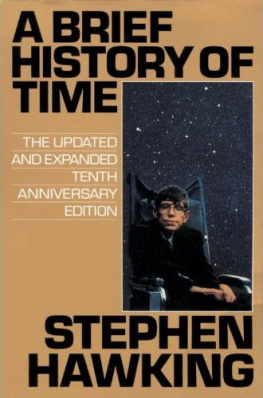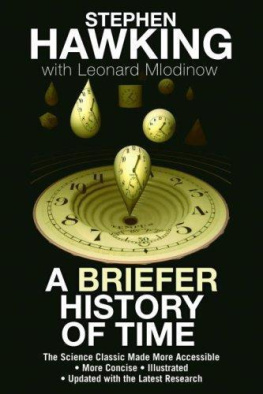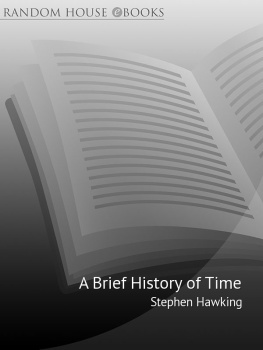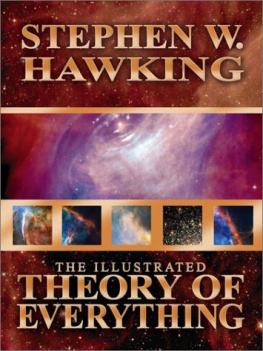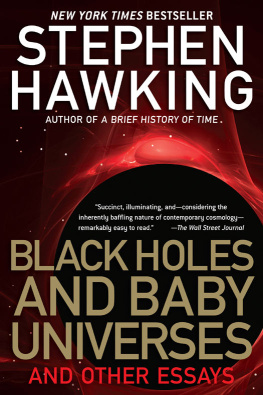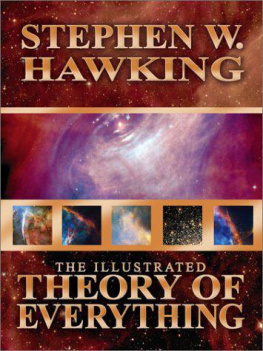About the Book
Was there a beginning of time? Could time run backwards? Is the universe infinite or does it have boundaries? These are just some of the questions considered in an internationally acclaimed masterpiece by one of the worlds greatest thinkers. It begins by reviewing the great theories of the cosmos from Newton to Einstein, before delving into the secrets which still lie at the heart of space and time, from the Big Bang to black holes, via spiral galaxies and strong theory. To this day A Brief History of Time remains a staple of the scientific canon, and its succinct and clear language continues to introduce millions to the universe and its wonders.
CONTENTS
A BRIEF
HISTORY
OF TIME
FROM THE BIG BANG
TO BLACK HOLES
STEPHEN HAWKING
ACKNOWLEDGMENTS
Many people have helped me in writing this book. My scientific colleagues have without exception been inspiring. Over the years my principal associates and collaborators were Roger Penrose, Robert Geroch, Brandon Carter, George Ellis, Gary Gibbons, Don Page and Jim Hartle. I owe a lot to them, and to my research students, who have always given me help when needed.
One of my students, Brian Whitt, gave me a lot of help writing the first edition of this book. My editor at Bantam Books, Peter Guzzardi, made innumerable comments which improved the book considerably. In addition, for this edition, I would like to thank Andrew Dunn, who helped me revise the text.
I could not have written this book without my communication system. The software, called Equalizer, was donated by Walt Waltosz of Words Plus Inc., in Lancaster, California. My speech synthesizer was donated by Speech Plus, of Sunnyvale, California. The synthesiser and laptop computer were mounted on my wheelchair by David Mason, of Cambridge Adaptive Communication Ltd. With this system I can communicate better now than before I lost my voice.
I have had a number of secretaries and assistants over the years in which I wrote and revised this book. On the secretarial side, Im very grateful to Judy Fella, Ann Ralph, Laura Gentry, Cheryl Billington and Sue Masey. My assistants have been Colin Williams, David Thomas, Raymond Laflamme, Nick Phillips, Andrew Dunn, Stuart Jamieson, Jonathan Brenchley, Tim Hunt, Simon Gill, Jon Rogers and Tom Kendall. They, my nurses, colleagues, friends and family have enabled me to live a very full life and to pursue my research despite my disability.
Stephen Hawking
FOREWORD
I didnt write a foreword to the original edition of A Brief History of Time. That was done by Carl Sagan. Instead, I wrote a short piece titled Acknowledgments in which I was advised to thank everyone. Some of the foundations that had given me support werent too pleased to have been mentioned, however, because it led to a great increase in applications.
I dont think anyone, my publishers, my agent, or myself, expected the book to do anything like as well as it did. It was in the London Sunday Times bestseller list for 237 weeks, longer than any other book (apparently, the Bible and Shakespeare arent counted). It has been translated into something like forty languages and has sold about one copy for every 750 men, women, and children in the world. As Nathan Myhrvold of Microsoft (a former post-doc of mine) remarked : I have sold more books on physics than Madonna has on sex.
The success of A Brief History indicates that there is widespread interest in the big questions like: where did we come from? And why is the universe the way it is?
I have taken the opportunity to update the book and include new theoretical and observational results obtained since the book was first published (on April Fools Day, 1988). I have included a new chapter on wormholes and time travel. Einsteins General Theory of Relativity seems to offer the possibility that we could create and maintain wormholes, little tubes that connect different regions of space-time. If so, we might be able to use them for rapid travel around the galaxy or travel back in time. Of course, we have not seen anyone from the future (or have we?) but I discuss a possible explanation for this.
I also describe the progress that has been made recently in finding dualities or correspondences between apparently different theories of physics. These correspondences are a strong indication that there is a complete unified theory of physics, but they also suggest that it may not be possible to express this theory in a single fundamental formulation. Instead, we may have to use different reflections of the underlying theory in different situations. It might be like our being unable to represent the surface of the earth on a single map and having to use different maps in different regions. This would be a revolution in our view of the unification of the laws of science but it would not change the most important point: that the universe is governed by a set of rational laws that we can discover and understand.
On the observational side, by far the most important development has been the measurement of fluctuations in the cosmic microwave background radiation by COBE (the Cosmic Background Explorer satellite) and other collaborations . These fluctuations are the fingerprints of creation, tiny initial irregularities in the otherwise smooth and uniform early universe that later grew into galaxies, stars, and all the structures we see around us. Their form agrees with the predictions of the proposal that the universe has no boundaries or edges in the imaginary time direction; but further observations will be necessary to distinguish this proposal from other possible explanations for the fluctuations in the background. However, within a few years we should know whether we can believe that we live in a universe that is completely self-contained and without beginning or end.
Stephen Hawking
Cambridge, May 1996
OUR PICTURE OF THE UNIVERSE
A WELL-KNOWN SCIENTIST (some say it was Bertrand Russell) once gave a public lecture on astronomy. He described how the earth orbits around the sun and how the sun, in turn, orbits around the center of a vast collection of stars called our galaxy. At the end of the lecture, a little old lady at the back of the room got up and said: What you have told us is rubbish. The world is really a flat plate supported on the back of a giant tortoise. The scientist gave a superior smile before replying, What is the tortoise standing on? Youre very clever, young man, very clever, said the old lady. But its turtles all the way down!
Most people would find the picture of our universe as an infinite tower of tortoises rather ridiculous, but why do we think we know better? What do we know about the universe, and how do we know it? Where did the universe come from, and where is it going? Did the universe have a beginning, and if so, what happened before then? What is the nature of time? Will it ever come to an end? Can we go back in time? Recent breakthroughs in physics, made possible in part by fantastic new technologies, suggest answers to some of these longstanding questions. Someday these answers may seem as obvious to us as the earth orbiting the sun or perhaps as ridiculous as a tower of tortoises. Only time (whatever that may be) will tell.
As long ago as 340 BC the Greek philosopher Aristotle, in his book On the Heavens, was able to put forward two good arguments for believing that the earth was a round sphere rather than a flat plate. First, he realized that eclipses of the moon were caused by the earth coming between the sun and the moon. The earths shadow on the moon was always round, which would be true only if the earth was spherical. If the earth had been a flat disk, the shadow would have been elongated and elliptical, unless the eclipse always occurred at a time when the sun was directly under the center of the disk. Second, the Greeks knew from their travels that the North Star appeared lower in the sky when viewed in the south than it did in more northerly regions. (Since the North Star lies over the North Pole, it appears to be directly above an observer at the North Pole, but to someone looking from the equator, it appears to lie just at the horizon.)
Next page
